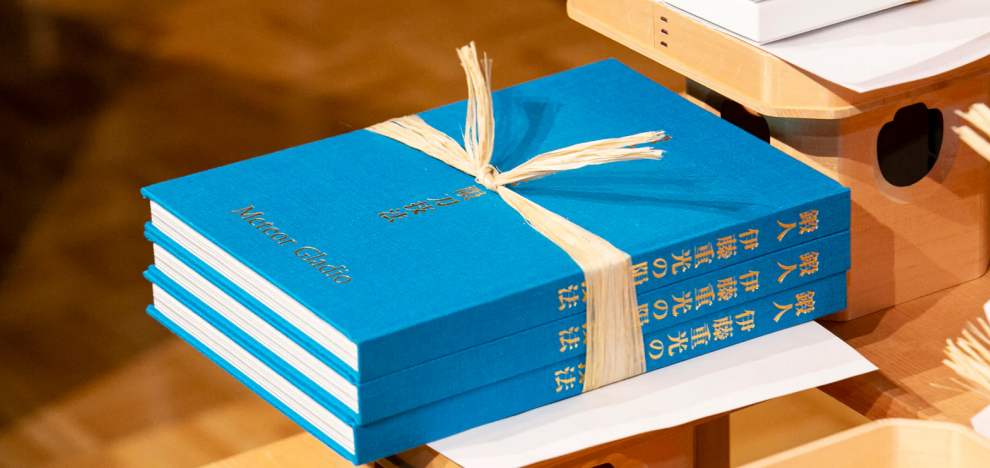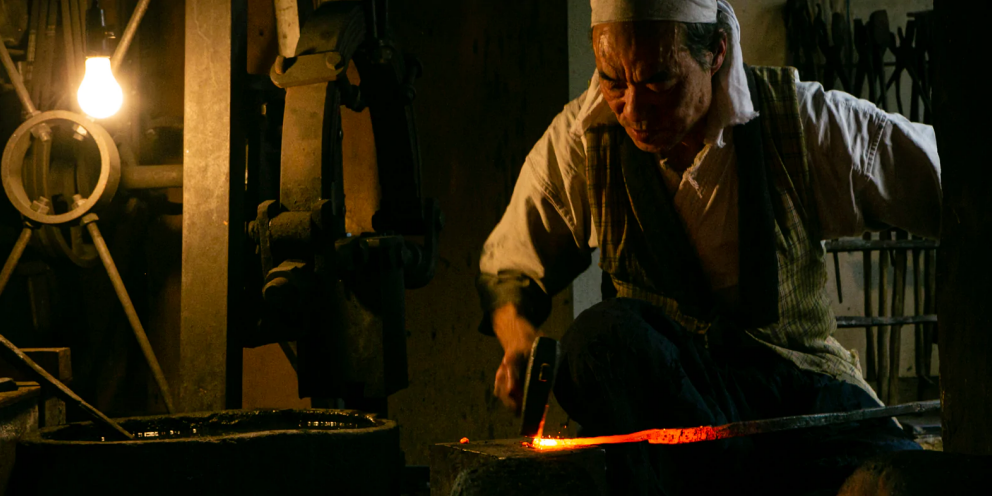Meteor Gladio Book
Meteoric Iron Blade Technology
Presented to the Emperor of Japan:
Revived in the Modern Age

Meteor Gladio presented in a Shinto ceremony
Meteorites enter the atmosphere at the astonishing speeds of 11–72 km per second and fall to the ground without burning-up. Many of these meteorites are the “cosmic memory” of primitive planets that collided with one another and scattered about 4.6 billion years ago during the formation of our solar system. Meteoritic iron is mainly composed of iron and nickel and is thought to have formed during the condensation and recrystallization of iron in the primitive solar system.

Rulers of past and present, regardless of their knowledge of the history of meteorites, were fascinated by them and found a special power in them. The meteoric blades of rulers such as King Tutankhamen of Egypt, the Mughal emperor of India, and the sabers of Tsar Alexander I of Russia have been valued as treasures that symbolize the most powerful rulers in history. These blades were either ordered to be manufactured or were offered to the rulers.
There have been attempts to make Japanese swords from meteoritic iron in Japan; however, because meteoritic iron contains many nonferrous metals such as nickel, it has been considered almost impossible to make such artifacts with 100% meteoritic iron. In fact, the sword presented to the Japanese Emperor Taisho contained only a small percentage of meteoritic iron.
But a modern swordsmith has made the impossible possible.
Profile of Swordsmith: Shigemitsu Ito

Shigemitsu Ito was born in 1953. From a young age, he grew up with a strong interest in the sound of a hammer being used by a blacksmith in his neighborhood. During his first year of junior high school he decided to become a swordsmith.
After graduating from high school, he began training as a swordsmith. In 1979, he became a certified artisan by the Agency for Cultural Affairs. The following year he became an independent swordsmith. Since then, he has been making swords with steel he smelted aiming to “reproduce the masterpieces from the Kamakura period (1185–1333), something no other swordsmith has been able to accomplish for the past 400 years.
He has been receiving requests from sword lovers in Japan and from abroad who were attracted to his independent approach and quality of swords. He has already produced over 500 swords.
In recent years, he has been experimenting with making swords using only meteoric iron, which requires extremely delicate and advanced forging techniques. He succeeded in this task by developing a unique methodology. In 2018, he provided a sword to be used in the ring-purification ritual for the 72nd Sumo champion wrestler, Kise-no-Sato.


This book is a collection of works produced to commemorate the 500th sword made by the rare swordsmith Shigemitsu Ito.
In order to reproduce the graceful appearance of his treasured items, including a sword made of meteoric iron, delivered as a sacred object and a sword used in the ring-entering ceremony of former Sumo Champion Kiseno-sato, the best printing and bookbinding techniques in Japan were generously introduced into the production process.
In Ito's approach to the production of Japanese swords, one can sense an important spirituality that modern people have forgotten.

NOTE: This book is in Japanese only.
Couldn't load pickup availability


Description
Meteor Gladio Book
Meteoric Iron Blade Technology
Presented to the Emperor of Japan:
Revived in the Modern Age

Meteor Gladio presented in a Shinto ceremony
Meteorites enter the atmosphere at the astonishing speeds of 11–72 km per second and fall to the ground without burning-up. Many of these meteorites are the “cosmic memory” of primitive planets that collided with one another and scattered about 4.6 billion years ago during the formation of our solar system. Meteoritic iron is mainly composed of iron and nickel and is thought to have formed during the condensation and recrystallization of iron in the primitive solar system.

Rulers of past and present, regardless of their knowledge of the history of meteorites, were fascinated by them and found a special power in them. The meteoric blades of rulers such as King Tutankhamen of Egypt, the Mughal emperor of India, and the sabers of Tsar Alexander I of Russia have been valued as treasures that symbolize the most powerful rulers in history. These blades were either ordered to be manufactured or were offered to the rulers.
There have been attempts to make Japanese swords from meteoritic iron in Japan; however, because meteoritic iron contains many nonferrous metals such as nickel, it has been considered almost impossible to make such artifacts with 100% meteoritic iron. In fact, the sword presented to the Japanese Emperor Taisho contained only a small percentage of meteoritic iron.
But a modern swordsmith has made the impossible possible.
Profile of Swordsmith: Shigemitsu Ito

Shigemitsu Ito was born in 1953. From a young age, he grew up with a strong interest in the sound of a hammer being used by a blacksmith in his neighborhood. During his first year of junior high school he decided to become a swordsmith.
After graduating from high school, he began training as a swordsmith. In 1979, he became a certified artisan by the Agency for Cultural Affairs. The following year he became an independent swordsmith. Since then, he has been making swords with steel he smelted aiming to “reproduce the masterpieces from the Kamakura period (1185–1333), something no other swordsmith has been able to accomplish for the past 400 years.
He has been receiving requests from sword lovers in Japan and from abroad who were attracted to his independent approach and quality of swords. He has already produced over 500 swords.
In recent years, he has been experimenting with making swords using only meteoric iron, which requires extremely delicate and advanced forging techniques. He succeeded in this task by developing a unique methodology. In 2018, he provided a sword to be used in the ring-purification ritual for the 72nd Sumo champion wrestler, Kise-no-Sato.


This book is a collection of works produced to commemorate the 500th sword made by the rare swordsmith Shigemitsu Ito.
In order to reproduce the graceful appearance of his treasured items, including a sword made of meteoric iron, delivered as a sacred object and a sword used in the ring-entering ceremony of former Sumo Champion Kiseno-sato, the best printing and bookbinding techniques in Japan were generously introduced into the production process.
In Ito's approach to the production of Japanese swords, one can sense an important spirituality that modern people have forgotten.

NOTE: This book is in Japanese only.


